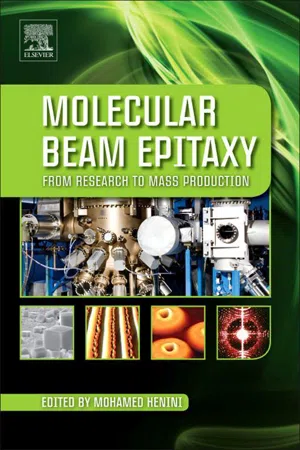
- 744 pages
- English
- ePUB (mobile friendly)
- Available on iOS & Android
About this book
This multi-contributor handbook discusses Molecular Beam Epitaxy (MBE), an epitaxial deposition technique which involves laying down layers of materials with atomic thicknesses on to substrates. It summarizes MBE research and application in epitaxial growth with close discussion and a 'how to' on processing molecular or atomic beams that occur on a surface of a heated crystalline substrate in a vacuum.MBE has expanded in importance over the past thirty years (in terms of unique authors, papers and conferences) from a pure research domain into commercial applications (prototype device structures and more at the advanced research stage). MBE is important because it enables new device phenomena and facilitates the production of multiple layered structures with extremely fine dimensional and compositional control. The techniques can be deployed wherever precise thin-film devices with enhanced and unique properties for computing, optics or photonics are required. This book covers the advances made by MBE both in research and mass production of electronic and optoelectronic devices. It includes new semiconductor materials, new device structures which are commercially available, and many more which are at the advanced research stage.- Condenses fundamental science of MBE into a modern reference, speeding up literature review- Discusses new materials, novel applications and new device structures, grounding current commercial applications with modern understanding in industry and research- Coverage of MBE as mass production epitaxial technology enhances processing efficiency and throughput for semiconductor industry and nanostructured semiconductor materials research community
Frequently asked questions
- Essential is ideal for learners and professionals who enjoy exploring a wide range of subjects. Access the Essential Library with 800,000+ trusted titles and best-sellers across business, personal growth, and the humanities. Includes unlimited reading time and Standard Read Aloud voice.
- Complete: Perfect for advanced learners and researchers needing full, unrestricted access. Unlock 1.4M+ books across hundreds of subjects, including academic and specialized titles. The Complete Plan also includes advanced features like Premium Read Aloud and Research Assistant.
Please note we cannot support devices running on iOS 13 and Android 7 or earlier. Learn more about using the app.
Information
Chapter 1
Molecular beam epitaxy
fundamentals, historical background and future prospects
Chapter Outline
1.1 Introduction
1.2 Basics of MBE
Table of contents
- Cover image
- Title page
- Table of Contents
- Copyright
- Preface
- Contributors
- Chapter 1. Molecular beam epitaxy: fundamentals, historical background and future prospects
- Chapter 2. Molecular beam epitaxy in the ultra-vacuum of space: present and near future
- Chapter 3. Growth of semiconductor nanowires by molecular beam epitaxy
- Chapter 4. Droplet epitaxy of nanostructures
- Chapter 5. Migration-enhanced epitaxy for low-dimensional structures
- Chapter 6. MBE growth of high-mobility 2DEG
- Chapter 7. Bismuth-containing III–V semiconductors: Epitaxial growth and physical properties
- Chapter 8. Molecular beam epitaxy of GaAsBi and related quaternary alloys
- Chapter 9. MBE of dilute-nitride optoelectronic devices
- Chapter 10. Effect of antimony coverage on InAs/GaAs (001) heteroepitaxy
- Chapter 11. Nonpolar cubic III-nitrides: from the basics of growth to device applications
- Chapter 12. Molecular beam epitaxy of low-bandgap InGaN
- Chapter 13. Molecular beam epitaxy of IV–VI semiconductors: multilayers, quantum dots and device applications
- Chapter 14. Epitaxial growth of thin films and quantum structures of II–VI visible-bandgap semiconductors
- Chapter 15. MBE of transparent semiconducting oxides
- Chapter 16. Zinc oxide materials and devices grown by MBE
- Chapter 17. Molecular beam epitaxy of complex oxides
- Chapter 18. Epitaxial systems combining oxides and semiconductors
- Chapter 19. Molecular beam epitaxy of III–V ferromagnetic semiconductors
- Chapter 20. Epitaxial magnetic layers grown by MBE: model systems to study the physics in nanomagnetism and spintronic
- Chapter 21. Atomic layer-by-layer molecular beam epitaxy of complex oxide films and heterostructures
- Chapter 22. Molecular beam epitaxy of semi-magnetic quantum dots
- Chapter 23. Graphene growth by molecular beam epitaxy
- Chapter 24. Growth and characterisation of fullerene/GaAs interfaces and C60-doped GaAs and AlGaAs layers
- Chapter 25. Molecular beam epitaxial growth and exotic electronic structure of topological insulators
- Chapter 26. Thin films of organic molecules: interfaces and epitaxial growth
- Chapter 27. Molecular beam epitaxy of wide-gap II–VI laser heterostructures
- Chapter 28. MBE growth of THz quantum cascade lasers
- Chapter 29. Systems and technology for production-scale molecular beam epitaxy
- Chapter 30. Mass production of optoelectronic devices
- Chapter 31. Mass production of sensors grown by MBE
- Index